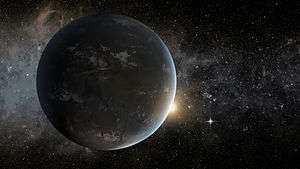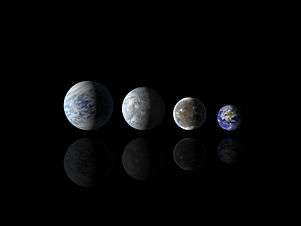Kepler-65
| Observation data Epoch Equinox | |
|---|---|
| Constellation | |
| Right ascension | 19:14:45.3 |
| Declination | +41:09:04.2 |
| Apparent magnitude (V) | 11.018 |
| Characteristics | |
| Astrometry | |
| Details | |
| Mass | 1.25 M☉ |
| Radius | 1.41 R☉ |
| Temperature | 6211 K |
| Metallicity [Fe/H] | +0.17 dex |
| Other designations | |
Kepler-65, KOI-85 | |
Kepler-65 is a star slightly more massive than the Sun and has at least three planets.
Planetary system
Three planets were announced in 2013. All three planets orbit very close to their star. Follow-up radial velocity measurements provided data too noisy to constrain the mass of planets.[1] Follow-up transit-timing variation analysis helped to measure the mass of Kepler-65d which revealed that it has significantly lower density than Earth.[2]
| Companion (in order from star) |
Mass | Semimajor axis (AU) |
Orbital period (days) |
Eccentricity | Inclination | Radius |
|---|---|---|---|---|---|---|
| b | — | 0.035 | 2.154910 | — | 79.07° | 1.42 R⊕ |
| c | <20 M⊕ | 0.068 | 5.859944 | — | 83.65° | 2.58 R⊕ |
| d | 2 M⊕ | 0.084 | 8.131146 | — | 84.8° | 1.52 R⊕ |
External links
References
- ↑ Asteroseismic determination of obliquities of the exoplanet systems Kepler-50 and Kepler-65: W. J. Chaplin, R. Sanchis-Ojeda, T. L. Campante, R. Handberg, D. Stello, J. N. Winn, S. Basu, J. Christensen-Dalsgaard, G. R. Davies, T. S. Metcalfe, L. A. Buchhave, D. A. Fischer, T. R. Bedding, W. D. Cochran, Y. Elsworth, R. L. Gilliland, S. Hekker, D. Huber, H. Isaacson, C. Karoff, S. D. Kawaler, H. Kjeldsen, D. W. Latham, M. N. Lund, M. Lundkvist, G. W. Marcy, A. Miglio, T. Barclay, J. J. Lissauer
- ↑ http://arxiv.org/abs/1310.7942
This article is issued from Wikipedia - version of the 7/25/2016. The text is available under the Creative Commons Attribution/Share Alike but additional terms may apply for the media files.


